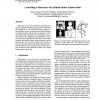Free Online Productivity Tools
i2Speak
i2Symbol
i2OCR
iTex2Img
iWeb2Print
iWeb2Shot
i2Type
iPdf2Split
iPdf2Merge
i2Bopomofo
i2Arabic
i2Style
i2Image
i2PDF
iLatex2Rtf
Sci2ools
ICRA
2003
IEEE
2003
IEEE
Controlling a marionette with human motion capture data
In this paper, we present a method for controlling a motorized, string-drivenmarionette using motion capture data from human actors. The motion data must be adapted for the marionette because its kinematic and dynamic properties differ from those of the human actor in degrees of freedom, limb length, workspace, mass distribution, sensors, and actuators. This adaptation is accomplished via an inverse kinematics algorithm that takes into account marker positions, joint motion ranges, string constraints, and potential energy. We also apply a feedforward controller to prevent extraneous swings of the hands. Experimental results show that our approach enables the marionette to perform motions that are qualitatively similar to the original human motion capture data.
| Added | 04 Jul 2010 |
| Updated | 04 Jul 2010 |
| Type | Conference |
| Year | 2003 |
| Where | ICRA |
| Authors | Katsu Yamane, Jessica K. Hodgins, H. Benjamin Brown |
Comments (0)

